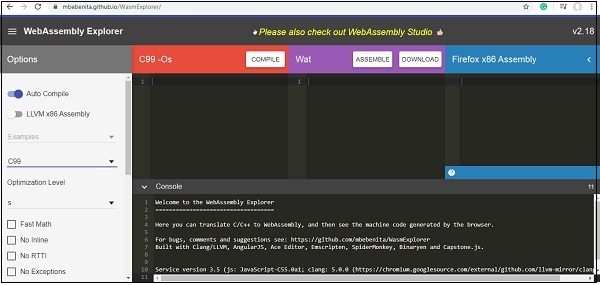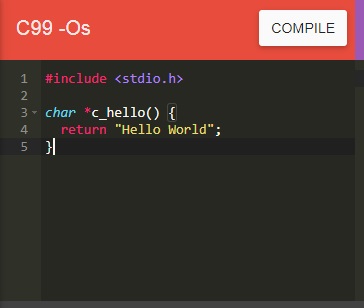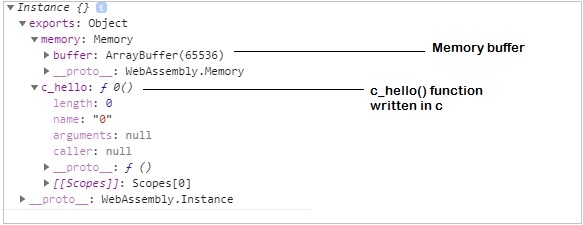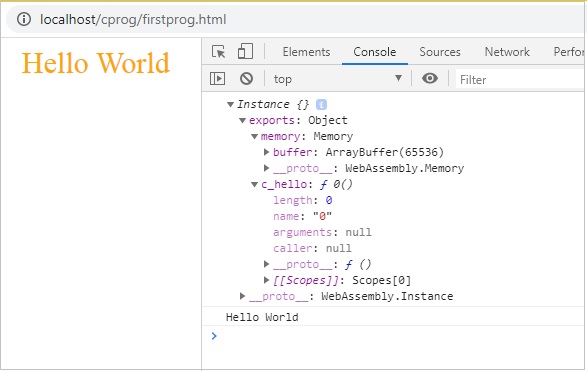WebAssembly - Hello World 示例
在本章中,我们将用 C 语言编写一个简单的程序,并将其转换为 .wasm 并在浏览器中执行相同的程序以获取文本"Hello World"。
将利用 wasm 资源管理器工具将 C 程序转换为 .wasm 并在 .html 文件中使用 .wasm。
https://mbebenita.github.io/WasmExplorer/ 上提供的 Wasm 浏览器工具如下所示 −

我们要使用的C代码如下 −
#include <stdio.h>
char *c_hello() {
return "Hello World";
}
使用 C 代码更新 wasm 浏览器中的第一个块,如下所示 −

单击"COMPILE"按钮编译为 WASM 和 WAT 以及 Firefox x86 webassemble,如下所示−

使用"下载"获取 .wasm 文件并将其另存为 firstprog.wasm。
创建一个名为firstprog.html的.html文件,如下所示 −
<!doctype html>
<html>
<head>
<meta charset="utf-8">
<title>WebAssembly Hello World</title>
</head>
<body>
<div id="textcontent"></div>
<script type="text/javascript">
//Your code from webassembly here
</script>
</body>
</html>
现在让我们使用firstprog.wasm从C函数c_hello()读取helloworld。
步骤 1
使用 fetch() api 读取firstprog.wasm代码。
步骤 2
.wasm 代码必须使用 ArrayBuffer 转换为 arraybuffer。 ArrayBuffer 对象将返回一个固定长度的二进制数据缓冲区。
到目前为止的代码如下 −
<script type="text/javascript">
fetch("firstprog.wasm") .then(bytes => bytes.arrayBuffer())
</script>
步骤 3
必须使用 WebAssembly.compile(buffer) 函数将 ArrayBuffer 中的字节编译到模块中。
代码如下所示 −
<script type="text/javascript">
fetch("firstprog.wasm")
.then(bytes => bytes.arrayBuffer())
.then(mod => WebAssembly.compile(mod))
</script>
步骤 4
要获取模块,我们必须调用 webassemble.instance 构造函数,如下所示 −
<script type="text/javascript">
fetch("firstprog.wasm")
.then(bytes => bytes.arrayBuffer())
.then(mod => WebAssembly.compile(mod))
.then(module => {return new WebAssembly.Instance(module) })
</script>
步骤 5
现在让我们控制台实例以在浏览器中查看详细信息。
<script type="text/javascript">
fetch("firstprog.wasm") .then(bytes => bytes.arrayBuffer())
.then(mod => WebAssembly.compile(mod)) .then(module => {
return new WebAssembly.Instance(module)
})
.then(instance => {
console.log(instance);
});
</script>
console.log详细信息如下所示 −

要从函数 c_hello() 中获取字符串"Hello World",我们需要在 javascript 中添加一些代码。
首先,获取内存缓冲区详细信息,如下所示 −
let buffer = instance.exports.memory.buffer;;
缓冲区值必须转换为类型化数组,以便我们可以从中读取值。 缓冲区中有字符串 Hello World。
要转换为类型化,请调用构造函数 Uint8Array,如下所示 −
let buffer = new Uint8Array(instance.exports.memory.buffer);
现在,我们可以在 for 循环中从缓冲区读取值。
现在让我们通过调用我们编写的函数来获取读取缓冲区的起点,如下所示 −
let test = instance.exports.c_hello();
现在,测试变量有了读取字符串的起点。 WebAssembly 没有任何字符串值,所有内容都存储为整数。
因此,当我们从缓冲区读取值时,它们将是一个整数值,我们需要使用 JavaScript 中的 fromCharCode() 将其转换为字符串。
代码如下 −
let mytext = "";
for (let i=test; buffer[i]; i++){
mytext += String.fromCharCode(buffer[i]);
}
现在,当您控制台 mytext 时,您应该会看到字符串"Hello World"。
示例
完整代码如下 −
<!doctype html>
<html>
<head>
<meta charset="utf-8">
<title>WebAssembly Add Function</title>
<style>
div {
font-size : 30px; text-align : center; color:orange;
}
</style>
</head>
<body>
<div id="textcontent"></div>
<script>
fetch("firstprog.wasm")
.then(bytes => bytes.arrayBuffer())
.then(mod => WebAssembly.compile(mod))
.then(module => {return new WebAssembly.Instance(module)})
.then(instance => {
console.log(instance);
let buffer = new Uint8Array(instance.exports.memory.buffer);
let test = instance.exports.c_hello();
let mytext = "";
for (let i=test; buffer[i]; i++) {
mytext += String.fromCharCode(buffer[i]);
}
console.log(mytext); document.getElementById("textcontent").innerHTML = mytext;
});
</script>
</body>
</html>
我们添加了一个div,并将内容添加到div中,因此字符串显示在浏览器上。
输出
输出如下所示 −



